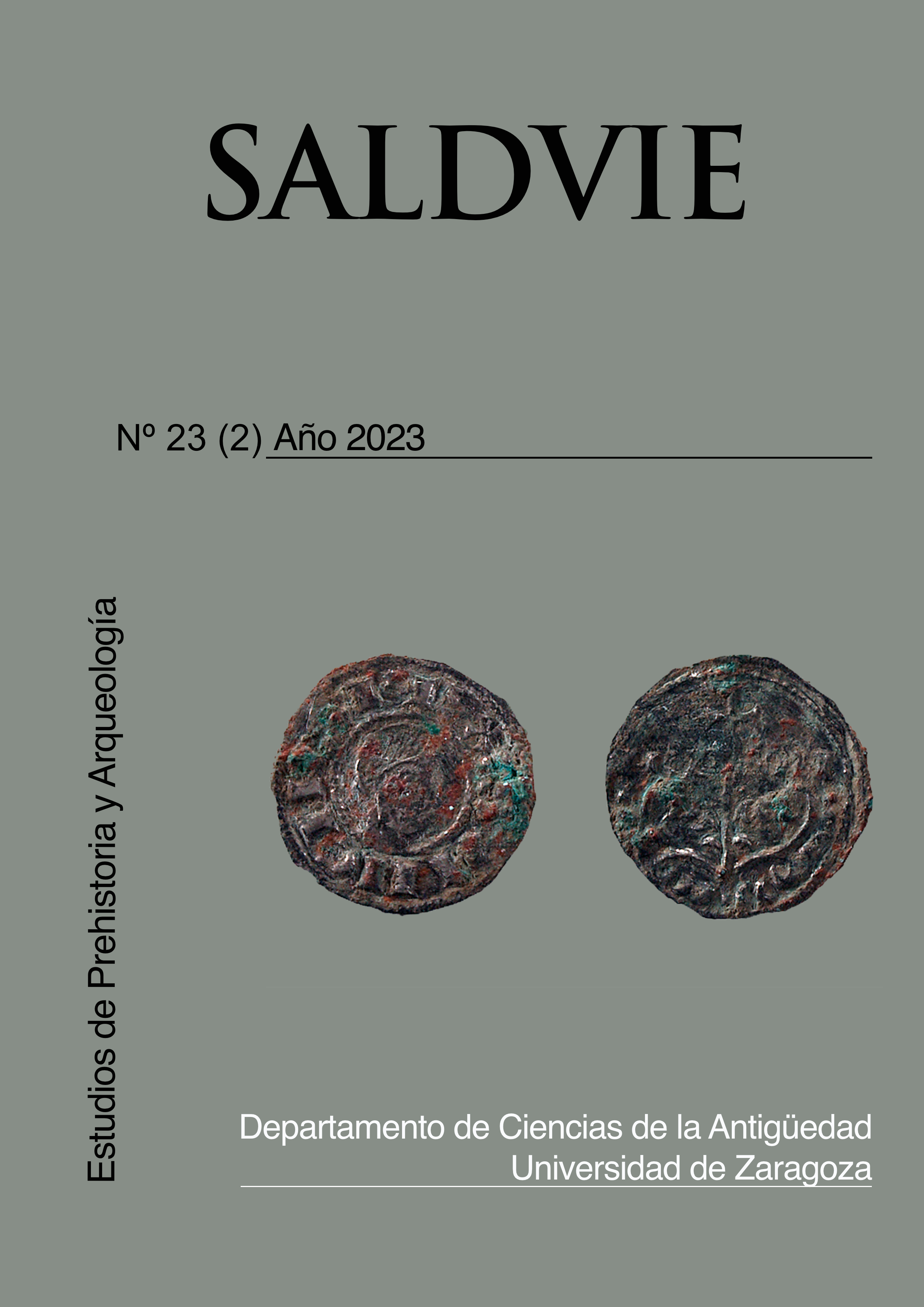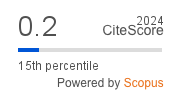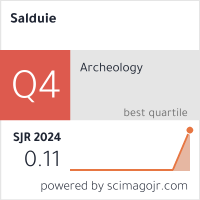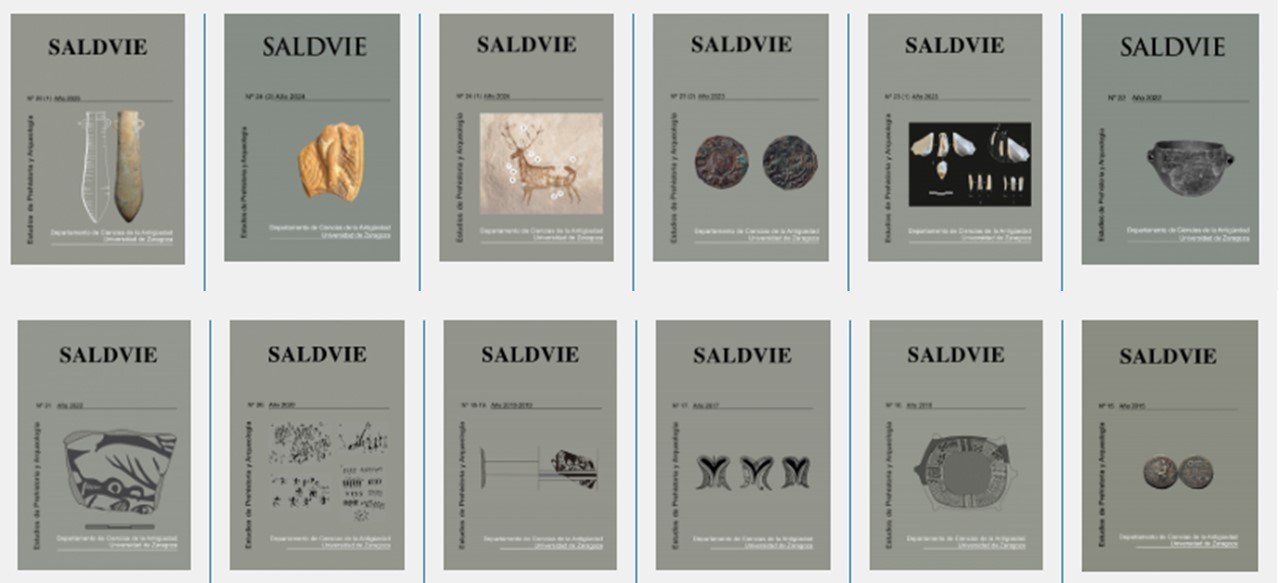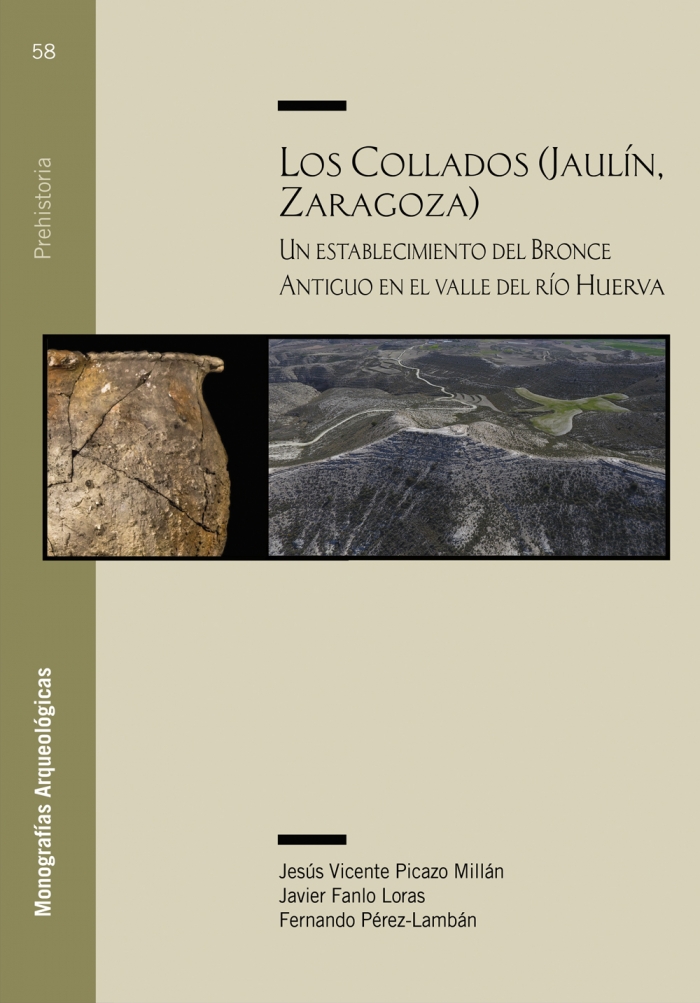Bajo la lupa y el microscopio: estado de la cuestión y perspectivas de futuro de los estudios de huellas de uso
DOI:
https://doi.org/10.26754/ojs_salduie/sald.202329860Palabras clave:
Huellas de uso, Industria lítica, Prehistoria, Funcionalidad, HistoriografíaResumen
Los análisis de huellas de uso, traceológicos o funcionales forman parte de una metodología aplicada a materiales arqueológicos que permite, a través del análisis microscópico de su superficie, determinar las actividades en las que han participado. En este trabajo se lleva a cabo una aproximación historiográfica de la disciplina desde sus orígenes hasta la actualidad, incidiendo en los estudios de huellas de uso aplicados a la industria lítica prehistórica.
Descargas
Referencias
Anderson-Gerfaud, P., Moss, E., Plisson, H. (1987). A quoi ont-ils servi? L’apport de l’analyse fonctionnelle. Bulletin de La Société Préhistorique Française, 84(8): 226-237.
Anderson, P. C., Korobkova, G. F., Longo, L., Plisson, H., Skakun, N. (2005). Various viewpoints on the work of S.A. Semenov. En L. Longo y N. Skakun (eds.): The Roots of UseWear Analysis: Selected Papers of S.A. Semenov (pp. 11-18). Memorie del Museo Cívico de Storia Naturale di Verona (2. serie), Sezione Scienze dell'Uomo, no. 7.
Asryan, L. y Ollé, A. (2020). Results of a functional study on the Middle to early Upper Pleistocene lithic assemblages from the Azokh 1 Cave site (South Caucasus). Quaternary International, 569–570: 168-180. https://doi.org/10.1016/j.quaint.2020.05.028
Bicho, N., Marreiros, J. Gibaja, J.F. (2015). Use–Wear and Residue Analysis in Archeology. En J.M. Marreiros, J.F. Gibaja y N. Ferreira Bicho (eds.): Use-Wear and Residue Analysis in Archaeology (pp. 1-5). Springer. New York.
Borel, A., Ollé, A., Vergès, J. M., Sala, R. (2014). Scanning electron and optical light microscopy: Two complementary approaches for the understanding and interpretation of usewear and residues on stone tools. Journal of Archaeological Science, 48(1): 46-59. https://doi.org/10.1016/j.jas.2013.06.031
Briz i Godino, I. (2003). Recensión Clemente, Risch y Gibaja (Eds.), 2002: Análisis Funcional. Su aplicación al estudio de sociedades prehistóricas. BAR International Series, 1073. Archaeopress. Oxford. RAMPAS, 6: 337-342.
Calvo Trías, M. (2007): Tallando la piedra. Formas, funciones y usos de los útiles prehistóricos. Ariel Prehistoria, Madrid.
Clemente Conte, I. (2004-2005). Recensión de la obra The Roots of Use-Wear Analysis: Selected Papers of S.A. Semenov. RAMPAS, 7: 191-195.
Clemente, I., Risch, R., Gibaja, J.F. (2002). Análisis Funcional: su aplicación al estudio de las sociedades prehistóricas. BAR International Series 1073. Archaeopress. Oxford.
Croft, S. (2021). Lithic residue analysis – A review and guide to techniques. BAR International Series 3023. Archaeopress. Oxford.
Curwen, E. C. (1930). Prehistoric Flint Sickles. Antiquity, 4(14): 179-186.
Delibes de Castro, G. (1974). Contribución al estudio de las funciones del hacha pulimentada. Resultados de la aplicación del sistema Semenov a 130 ejemplares de Tierra de Campos. Zephyrus, 25: 151-154.
Evans, J. (1872). The ancient stone implements, weapons and ornaments of Great Britain. Longmans, Green, Reader and Dyer, London.
Evans, A.A. y Donahue, R. E. (2008). Laser scanning confocal microscopy: a potential technique for the study of lithic microwear. Journal of Archaeological Science, 35 (8): 22232230. https://doi.org/10.1016/j.jas.2008.02.006
Fernández-Marchena, J. L., García-Argudo, G., Pedergnana, A., Valverde, I. (2017). Líneas, manchas y cía. Pautas metodológicas para una adecuada interpretación funcional. En L. Agudo Pérez, C. Duarte, A. García Escarzaga, J. M. Geiling, A. Higher Pliego, S. Núñez de la Fuente, F. J. Rodríguez Santos y R. Suárez Revilla (Eds.) IX Jornadas de Jóvenes en Investigación Arqueológica. Santander 8-11 de junio de 2016 (pp. 241–250).
Frison, G. C. (1968). A Functional Analysis of Certain Chipped Stone Tools. American Antiquity, 33(2)149-155.
Fuentes, R. y Pawlik, A. (2023). Barely scratched the surface: Development and future directions of lithic use-wear analysis in Island Southeast Asia. Archaeological Research in Asia, 33. https://doi.org/10.1016/j.ara. 2022.100413
Gibaja Bao, J. F. (2007). Estudios de traceología y funcionalidad. Praxis Archaelogica, 2: 49-74.
Gijn, A. L. van (1989). The wear and tear of flint. Principles of functional analysis applied to Dutch Neolithic assemblages. Analecta Praehistorica Leidensia 22, University of Leiden, Leiden.
González Urquijo, J. E. e Ibáñez Estévez, J. J. (1994). Metodología de análisis funcional de instrumentos tallados en sílex. Universidad de Deusto. Cuadernos de Arqueología, 14. Bilbao.
Grace, R. (1989). Interpreting the Function of Stone Tools: The quantification and computerisation of microwear analysis. BAR Int. Series 474. Archaeopress. Oxford.
Gutiérrez Sáez, C. (1990). Introducción a las huellas de uso: los resultados de la experimentación. Espacio, Tiempo y Forma, Serie I, Prehistoria y Arqueología, t. 3: 15-53.
Gutiérrez Sáez, C. (1991). Notas en torno a la identificación en las huellas de uso: la cuestión del pulimento. CuPAUAM, 18, 21-33.
Gutiérrez Sáez, C. (1996). Traceología. Pautas de análisis experimental. Foro. Arqueología, proyectos y publicaciones, S.L. Madrid.
Gutiérrez Sáez, C., González Urquijo, J. E., Ibáñez Estévez, J. J. (1988). Alteraciones microscópicas en el tratamiento convencional del material lítico: su incidencia en las huellas de uso. Munibe, 6: 83-89.
Hayden, B. (1979). Lithic use-wear analysis. Academic Press, Inc. New York.
Hayden, B., y Kamminga, J. (1973). Gould. Koster, and Sontz on “Microwear”: a critical review. Newsletter of Lithic Technology, 2(1/2), 3-8.
Hayden, B. y Kamminga, J. (1979). An introduction to Use-Wear: The First CLUW. En B. Hayden (ed.): Lithic use-wear analysis (pp. 1-13). Academic Press, Inc. New York.
Hernández, H.H. y García Rojas, M. (2019). Revisando los clásicos: tecnología prehistórica. Estudio de las herramientas y objetos antiguos a través de las huellas de uso de Sergei Aristarkhovich Semenov. Revista ArkeoGazte Aldizkaria, nº 9: 311-326.
Holley, G. A. y Bene, T.A. del (1981). An Evaluation of Keeley’s Microwear Approach. Journal of Archaeological Science, 8: 337–347. https://doi.org/10.1016/0305-4403(81)90033-9
Hurcombe, L. (1988). Some Criticisms and Suggestions in Response to Newcomer et al. (1986). Journal of Archaeological Science, 15: 1-10. https://doi.org/10.1016/0305-4403(88)90014-3
Ibáñez, J. J. y Mazzucco, N. (2021). Quantitative use-wear analysis of stone tools: Measuring how the intensity of use affects the identification of the worked material. PLOS ONE, 16(9), e0257266. https://doi.org/10.1371/journal.pone.0257266
Jardón Giner, P. (1990). La metodología del análisis traceológico y su aplicación a conjuntos líticos prehistóricos. SAGVNTVM, 23: 9-37.
Kajiwara, H y Akoshima, K. (1981): An experimental study of microwear polish on shale artifacts. Kokogaku Zasshi, 67 (1): 1-36.
Keeley, L. H. (1974a): Technique and Methodology in Microwear Studies: A Critical Review. World Archaeology, 5(3): 323-336. https://doi.org/10.1080/00438243.1974.9979577
Keeley, L. H. (1974b). The Methodology of Microwear Analysis: A Comment on Nance, American Antiquity, 39(1): 126-128. https://doi.org/10.2307/279228
Keeley, L. H. (1980): Experimental determination of stone tools uses: a microwear analysis, The University of Chicago Press. London.
Keeley, L. H. (1981). Reply to Holley and del Bene. Journal of Archaeological Science, 8: 348352. https://doi.org/10. 1016/0305-4403(81)90034-0
Keeley, L. H. y Newcomer, M. H. (1977). Microwear Analysis of Experimental Flint Tools: a Test Case. Journal of Archaeological Science, 4: 29-62. https://doi.org/10.1016/0305-4403(77)90111-X
Klejn, L. S. (1993). La arqueología soviética. Historia y teoría de una escuela desconocida. Crítica, Barcelona.
Knutsson, K. (1988). Patterns of tool use. Scanning electron microscopy on experimental quartz tools. Societas Archaeologica Upsaliensis, AVN 10, Uppsala.
Knutsson, H. y Taffinder, J. (1986). Microwear traces on porphyry and hälleflint. Preliminary results of experiments. En L.R. Owen y G. Unrath (eds.): Technical aspects of microwear studies on stone tools (pp. 29-34). Early Man News 9/10/11.
Korobkova, G. F. (1984). El análisis experimental y las huellas de uso en el estudio de la economía de las sociedades antiguas. Cuadernos de Prehistoria y Arqueología de La Universidad de Granada, 9, 305-325. https://doi.org/10.30827/cpag.v9i0.1239
Laborda Martínez, M. A. (2010). Análisis de huellas de uso. Su aplicación al estudio de la funcionalidad del instrumental lítico de la Cueva de Zatoya (Navarra). Tesis doctoral. Universidad de Navarra.
Levitt, J. (1979). A review of experimental traceological research in the USSR. En B. Hayden (ed.): Lithic use-wear analysis (pp. 27-39). Academic Press. New York.
Lubbock, J. (1865). Prehistoric times: as illustrated by ancient remains, and the manners and customs of modern savages. Edition Lord Avebury (1913). Williams and Norgate. London.
Mansur-Franchomme, M.E. (1983). Scanning electron microscopy of dry hide working tools: the role of abrasives and humidity in microwear polish formation. Journal of Archaeological Science, 10: 223-230. https://doi.org/10.1016/0305-4403(83)90005-5
Mansur-Franchomme, M.E. (1984). Préhistoire de Patagonie : L'industrie 'Nivel 11' de la province de Santa Cruz (Argentine). Technologie lithique et traces d'utilisation. BAR International Series 216. Archaeopress. Oxford.
Mansur-Franchomme, M.E. (1986). Microscopie du matériel lithique préhistorique. Traces d'utilisation, altérations naturelles, accidentelles et technologiques. Exemples de Patagonia, Cahiers du Quaternaire 9, CNRS, Paris.
Marreiros, J., Mazzucco, N., Gibaja, J.F., Bicho, N. (2015). Macro and Micro Evidences from the Past: The State of the Art of Archeological Use-Wear Studies. En J.M. Marreiros, J. F. Gibaja, N. Ferreira Bicho: Use-Wear and Residue Analysis in Archaeology, (pp. 5-26). Springer. New York.
Martín Lerma, I. (2008): Análisis microscópico de la industria lítica: la Traceología. Panta Rei III, 2ª época, 15-25. https://doi.org/10.6018/pantarei/2008/2
Martín-Viveros, J. y Ollé, A. (2020a). Use-wear and residue mapping on experimental chert tools. A multi-scalar approach combining digital 3D, optical, and scanning electron microscopy.Journal Archaeological Science: Reports,30. https://doi.org/10.1016/j.jasrep.2020.102236.
Martín-Viveros, J. I. y Ollé, A. (2020b). Using 3D digital microscopy and SEM-EDX for in-situ residue analysis: A multi-analytical contextual approach on experimental stone tools. Quaternary International, 569-570: 228-262. https://doi.org/10.1016/j.quaint.2020.06.046
Martínez Molina, K. (2005). Análisis funcional de industrias líticas del Pleistoceno superior. El Paleolítico medio del Abric Romaní (Capellades, Barcelona) y el Paleolítico superior de Üçagizli (Hatay, Turquía) y del Molí del Salt (Vimbodí, Tarragona). Cambios en los patrones funcionales entre el paleolítico medio y superior. Tesis Doctoral. Universidad Rovira i Virgili.
Mazo Pérez, C. (1989). Análisis de huellas de uso en útiles de sílex del Paleolítico: Aplicación del método al estudio del nivel magdaleniense de Abauntz (Arraiz, Navarra). Tesis doctoral. Universidad de Zaragoza.
Mazo Pérez, C. (1991). Glosario y cuerpo bibliográfico de los estudios funcionales en Prehistoria. Universidad de Zaragoza.
Mazo Pérez, C. (1997). Análisis de huellas de uso: ‹‹del dicho al hecho…››. Veleia, 14: 9-39.
Mazzucco, N. (2012). Crónica: Use-wear 2012: International Conference on Use- Wear Analysis (Faro. 10-12 de octubre de 2012). RAMPAS, 14: 181-191.
Moir, J. R. (1914). The Striation of Flint Surfaces. Man, 14: 177-181.
Monnier, G. F., Hauck, T. C., Feinberg, J. M., Luo, B., Le Tensorer, J. M., Sakhel, H. al (2013). A multi-analytical methodology of lithic residue analysis applied to Paleolithic tools from Hummal, Syria. Journal of Archaeological Science, 40(10): 3722-3739. https://doi.org/10.1016/j.jas.2013.03.018
Mortillet, G. de (1883). Le Préhistorique: antiquité de l’homme. C. Reinwald, Paris.
Moss, E.H. (1983). The functional analysis of flint implements: Pincevent and Pont d’Ambon: two case studies from the French final Palaeolithic. BAR International Series 177. Archaeopress. Oxford.
Moss, E. H. (1987). A Review of “Investigating Microwear Polishes with Blind Tests.” Journal of Archaeological Science, 14: 473-481. https://doi.org/10.1016/0305-4403(87)90033-1
Nero, R. W. (1957). A “Graver” Site in Wisconsin. American Antiquity, 22(3): 300-304.https://doi.org/10.2307/276575
Newcomer, M., Grace, R., Unger-Hamilton, R. (1986). Investigating Microwear Polishes with Blind Tests. Journal of Archeological Science, 13: 203-205. https://doi.org/10.1016/0305-4403(86)90059-2
Nilsson, S. (1868). The Primitive Inhabitants of Scandinavia. An essay on comparative ethnography, and a contribution to the history of the development of mankind: Containing a description of the implements, dwellings, tombs and mode of living of the savages in the North of Europe during the Stone Age. Longmans, Green and CO. London (3ª Edición).
Odell, G.H. y Odell-Vereecken, F. (1980). Verifying the Reliability of Lithic Use-Wear Assessments by “Blind Tests”: the Low-Power Approach. Journal of Field Archaeology, 7: 87-120. https://doi.org/10.2307/529584
Olausson, D. S. (1980). Starting from scratch: the history of edge-wear research from 1838 to 1978. Lithic Technology, 9(2): 48–60.
Ollé, A. (2003). Variabilitat i patrons funcionals en els sistemes tècnics de mode 2. Anàlisi de les deformacions d’ús en els conjunts lítics del Riparo Esterno de Grotta Paglicci (Rignano Garganico, Foggia), Áridos (Arganda, Madrid) i Galería-TN (Sierra de Atapuerca, Burgos). Tesis Doctoral. Universidad Rovira i Virgili.
Ollé, A. y Vergès, J. M. (2008). SEM functional analysis and the mechanism of microwear formation. En L. Longo, N. Skakun (eds.): ‘Prehistoric Technology’ 40 Years Later: Functional studies and the Russian Legacy, Proceedings of the International Congress Verona (Italy), 2023 April 2005 (pp. 39-49). BAR International Series 1783, Archaeopress. Oxford.
Ollé, A. y Vergès, J. M. (2014). The use of sequential experiments and SEM in documenting stone tool microwear. Journal of Archaeological Science, 48(1): 60-72. https://doi.org/10.1016/j.jas.2013.10.028
Pawlik, A. F. (2004): Identification of hafting traces and residues by scanning electron microscopy and energy-dispersive analysis of X-rays. En E.A. Walker, F. Wenban-Smith, F. Healy (eds.): Lithics in Action: Papers from the conference Lithic Studies in the Year 2000 (pp. 169–179). Oxbow Books. Oxford.
Pedergnana, A. y Ollé, A. (2018). Building an Experimental Comparative Reference Collection for Lithic Micro-Re-sidue Analysis Based on a Multi-Analytical Approach. Journal of Archaeological Method and Theory, 25(1): 117-154. https://doi.org/10.1007/s10816-017-9337z
Pedergnana, A., Asryan, L., Fernández-Marchena, J. L., Ollé, A. (2016). Modern contaminants affecting microscopic residue analysis on stone tools: A word of caution. Micron, 86: 1–21. https://doi.org/10.1016/j.micron.2016.04.003
Pedergnana, A., Calandra, I., Evans, A. A., Bob, K., Hildebrandt, A., Ollé, A. (2020a): Polish is quantitatively different on quartzite flakes used on different worked materials. PLoS ONE, 15(12). https://doi.org/10.1371/ journal.pone.0243295
Pedergnana, A., Ollé, A., Evans, A. A. (2020b). A new combined approach using confocal and scanning electron microscopy to image surface modifications on quartzite. Journal of Archaeological Science: Reports, 30. https://doi.org/10.1016/j.jasrep.2020.102237
Pfeiffer, L. (1912): Die steinzeitliche Technik und ihre Beziehungen zur Gegenwart: ein Beitrag zur Gaschichte der Arbeit. Festschrift zur XLIII algemeinen Versammlung der deutschen anthropologischen Gesellshaft Vol. 1. Verlag von Gustav Fischer, Jena.
Phillips, P. (1988). Traceology (Microwear) studies in the USSR. World Archaeology, 19(3): 349-356. https://doi.org/10.1080/00438243.1988.9980045
Plisson, H. (1985). Étude fonctionnelle d'outillages lithiques préhistoriques par l'analyse des micro-usures: Recherche méthodologique et archéologique. Thèse de 3 cycle. Université Paris I Pantheon Sorbonne.
Plisson, H. (1988). Technologie et tracéologie des outils lithiques moustériens en Union Soviétique: Les travaux de V.E. Shchelinskiï. L’Homme de Néandertal, La Technique, 4: 121168.
Quente, P. (1914). Steinzeitliche Ackerbaugeräte aus der Ostprignitz, Erdhacken und Pflüge, und ihre Schaftungsmöglichkeit. Praehistorische Zeitschrift, VI: 180–187. https://doi.org/10.1515/prhz.1914.6.1-2.173
Rau, C. (1864). Agricultural Implements of the North American Stone Period. Smithsonian Institution, Annual Report for 1863: 379-80.
Rodríguez Rodríguez, A. C. (1998). Primeras experiencias de análisis funcional en los instrumentos de basalto tallado de Canarias. El ejemplo del material prehistórico de la isla de La Palma. Vegueta: Anuario de La Facultad de Geografía e Historia, 3: 29-46.
Semenov, S. A. (1970a). Prehistoric Technology: An Experimental Study of the oldest tools and artefacts from traces of manufacture and wear, Cory, Adams and Mackay, London.
Semenov, S.A. (1970b). The forms and funktions of the oldest tools. (A reply to Prof. F. Bordes). Quartär, 21: 1-20.
Semenov, S.A. (1981). Tecnología Prehistórica, Akal, Madrid.
Shea, J. J. (1988). Methodological considerations affecting the choice of analytical techniques in lithic use-wear analysis: tests, results and application. En S. Beyries, S. (ed.): Industries lithiques tracéologie et technologie (pp. 65-82). BAR International Series 411(ii). Archaeopress. Oxford.
Skakun, N. y Terekhina, V. (2017). Significance of experimental works in research of functions of ancient tools (after materials of the settlement Bodaki of Tripolye culture). Quaternary International, 427: 6–24. https://doi.org/10.1016/j.quaint.2016.01.030
Sonnenfeld, J. (1962). Interpreting the Function of Primitive Implements. Antiquity, 28(1): 56-65. https://doi.org/10.2307/278078
Spurrell, F. C. J. (1884). On Some Palaeolithic Knapping Tools and Modes of Using Them. The Journal of the Anthropological Institute of Great Britain and Ireland, 13: 109-118. https://doi.org/10.2307/2842002
Spurrell, F. C. J. (1892a). Some Flints from Egypt of 4th Dynasty. Archaeological Journal, 49, 48-52. https://doi.org/10.5284/1018054
Spurrell, F. C. J. (1892b). Notes on early sickles. Archaeological Journal, 49: 53-69. https://doi.org/10.5284/1018054
Sussman, C. (1985). Microwear on quartz: Fact or fiction?. World Archaeology, 17(1): 101-111. https://doi.org/10.1080/00438243.1985.9979953
Sussman, C. (1988). A microscopic analysis of use-wear and polish formation on experimental quartz tools. BAR International Series 395. Archaeopress. Oxford.
Thrane, H. (1984). Frederik Sehested : a Danish pioneer. Antiquity, LVIII: 113-116. https://doi.org/10.1017/S0003598X0005153X
Tringham, R., Cooper, G., Odell, G., Voytek, B., Whitman, A. (1974). Experimentation in the formation of edge damage: A new Approach to Lithic Analysis. Journal of Field Archaeology, 1:171-196. https://doi.org/10.1179/jfa.1974.1.1-2.171
Vaughan, P. C. (1985). Use-wear analysis of flaked Stone Tools. The University of Arizona Press.
Vaughan, P. C. (1981): Lithic microwear experimentation and the functional analysis of a lower magdalenian Stone tolos assemblage. UMI Dissertation Information Service, Publication nº 8208050.
Vayson de Pradenne, A. (1920). La plus ancienne industrie de Saint-Acheul. L’Anthropologie, XXX: 441-496.
Vayson de Pradenne, A. (1922). L’étude des outillages en pierre. L’Anthropologie, XXXII: 1-38.
Vila Mitjà, A. (1980). Estudi de les traces d’ús i desgast en els instruments de sílex. Fonaments: prehistòria i món antic als Països Catalans, 2: 11-55.
Vila Mitjà, A. (1981): Introducción. En S.A. Semenov: Tecnología prehistórica (pp. 1-4). Akal, Madrid.
Vila Mitjà, A. y Clemente, I. (2000). Reflexiones en torno al Congreso-Homenaje a S. A. Semenov. RAMPAS, 3: 345-354.
Warren, S. H. (1914). The Experimental Investigation of Flint Fracture and its Application to Problems of Human Implements. The Journal of the Royal Anthropological Institute of Great Britain and Ireland, 44: 412–450. https://doi.org/10.2307/2843364
Witthoft, J. (1955). Worn stone tools from southeastern Pennsylvania. Pennsylvania Archaeologist, 25: 16-31.
Yerkes, R. (2019). Lawrence H. Keeley’s contributions to the use of microwear analysis in reconstructions of past human behavior (1972–2017). Journal of Archaeological Science: Reports, 27. https://doi.org/10.1016/j.jasrep. 2019.101937
Descargas
Publicado
Número
Sección
Licencia
Derechos de autor 2024 Salduie

Esta obra está bajo una licencia internacional Creative Commons Atribución-NoComercial-SinDerivadas 4.0.
SALDUIE conserva los derechos patrimoniales (copyright) de los artículos publicadas, autorizando a usar, difundir, transmitir y exponer públicamente su contenido, siempre que se cite la autoría, la url y la revista, y no se use para fines comerciales. También se reserva el derecho de la reproducción de los artículos en copia impresa, formato de documento portátil (.pdf) o ediciones HTML de JoS. Los autores están de acuerdo con la licencia de uso utilizada por la revista, al igual que con las condiciones de autoarchivo y su política de acceso abierto.
